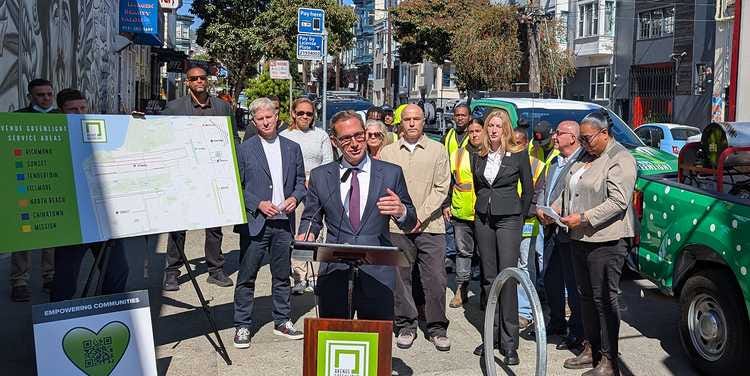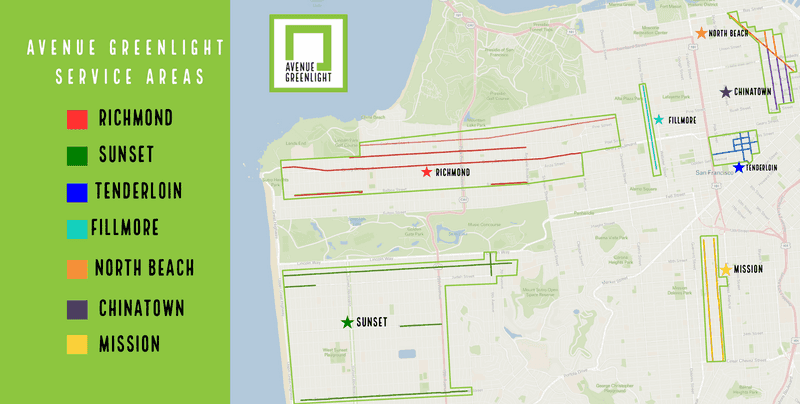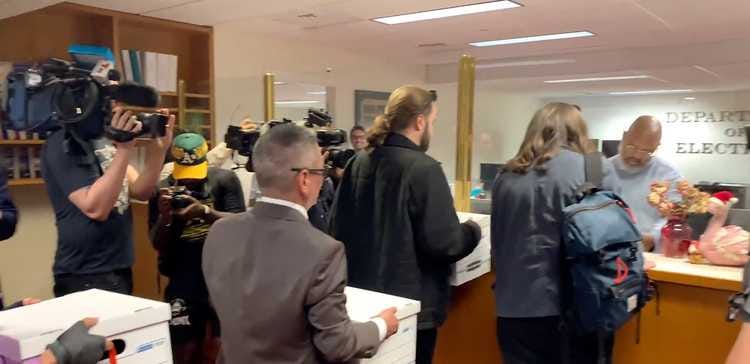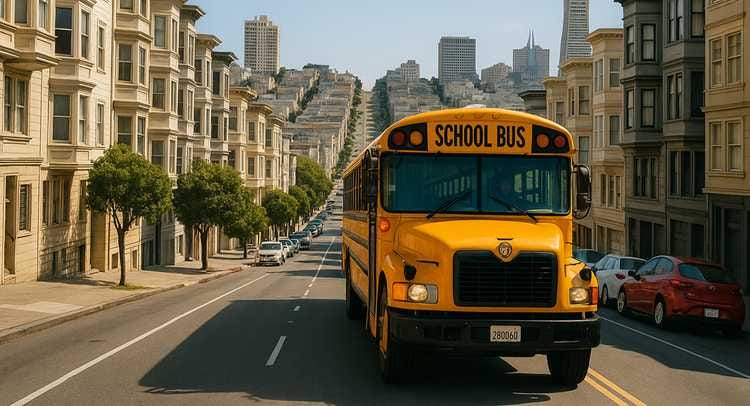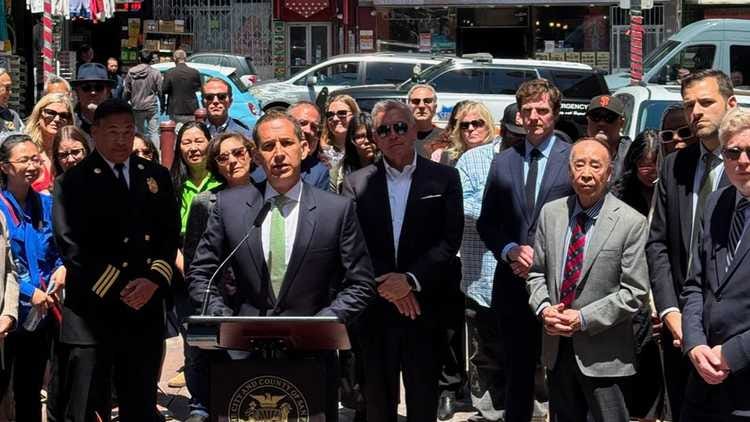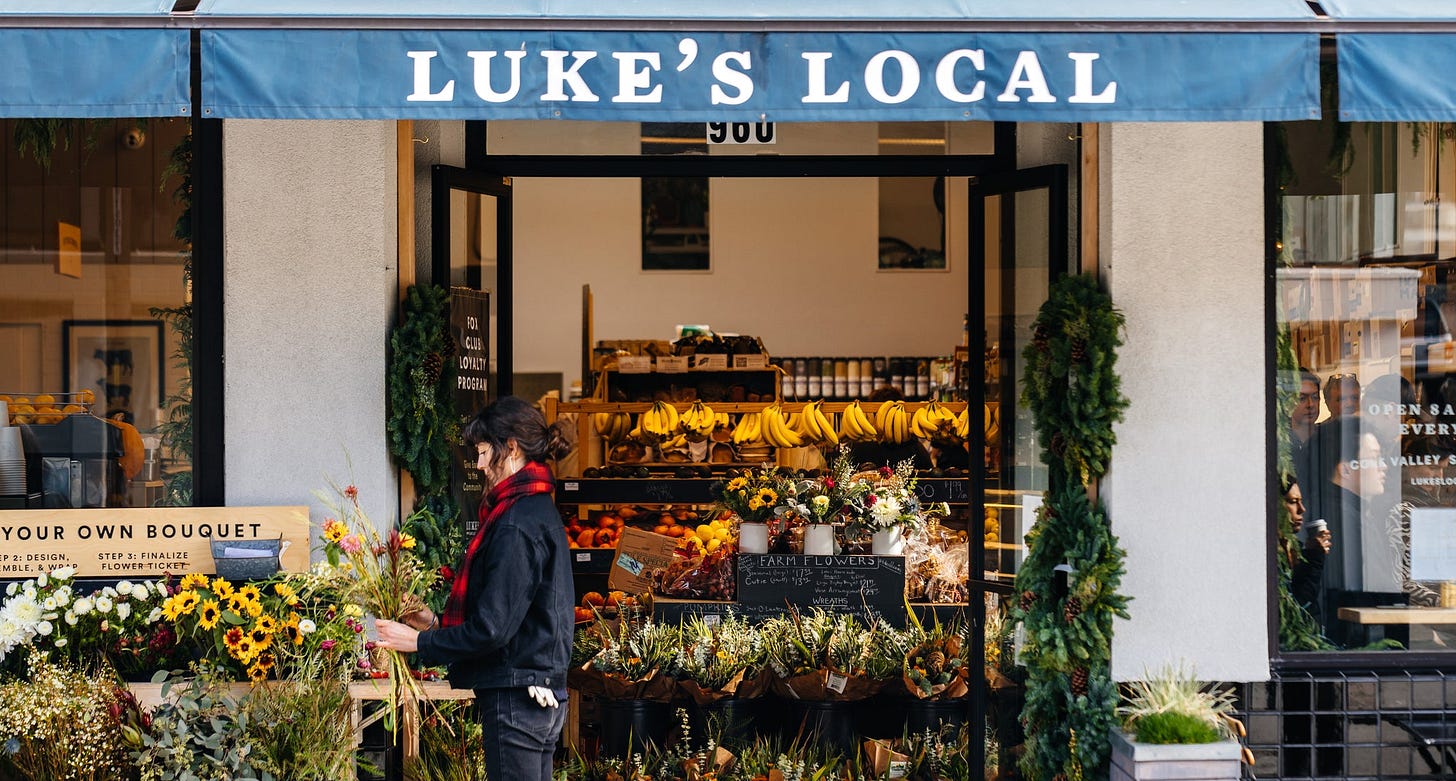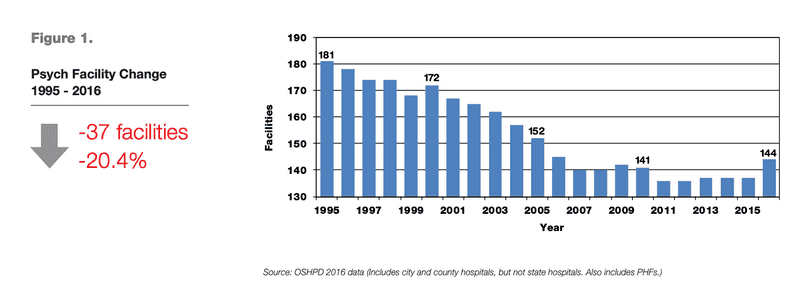Avenue Greenlight launches $3M sidewalk power-washing program
PLUS: Engardio Recall Campaign Submits 10,985 Signatures, Likely To Qualify
What You Need To Know
Here’s what happened around the city for the week of May 18, 2025:
- Avenue Greenlight launches $3M sidewalk power-washing program
- Engardio Recall Campaign Submits 10,985 Signatures, Likely To Qualify
- SFUSD Reverses Layoffs And Will Hire More Teachers Amid Fiscal Turnaround
- Major Common-sense Permitting Reforms Introduced by Mayor and Supervisors
Research:
- San Francisco Pays for the Mental Health System the State Dismantled
Recent & upcoming openings:
- Luke’s Local launches in the Inner Sunset
Events:
- Carnaval in the Mission today and tomorrow
Avenue Greenlight launches $3M sidewalk power-washing program
Published May 23, 2025
Avenue Greenlight, a nonprofit that funds neighborhood improvements, is launching a new initiative to power-wash sidewalks across seven neighborhoods, funded by philanthropists Chris Larsen and Michael Moritz.
The Facts
Pressure washing is coming to sidewalks in the Tenderloin, Mission, Sunset, Richmond, Chinatown, Fillmore, and North Beach thanks to a new initiative by Avenue Greenlight. Philanthropists Chris Larsen (Ripple co-founder) and Michael Moritz (Sequoia Capital partner and chairman of the Standard) are funding the $3 million initiative. Mayor Lurie joined the announcement in the Mission and praised the public-private partnership.
The Context
San Francisco has long struggled with dirty sidewalks, especially in commercial corridors and the Tenderloin and Mission neighborhoods. Despite good work from the Department of Public Works, the city has not been able to keep up with the demand for sidewalk cleaning. Even at 16th & Mission, which is power washed every day, the sidewalks on the surrounding streets and allies are often filthy.
Avenue Greenlight is known for funding the installation and maintenance of string lights along commercial corridors like Valencia and Polk.
The GrowSF Take
We love to see this kind of public-private partnership solve issues in the City, and applaud Chris Larsen and Michael Moritz for funding the effort. As a resident of the Mission near 16th & Mission, I'm particularly thrilled to learn that the side-streets like Julian and Hoff will be included in the cleaning effort. And we are disappointed, though not surprised, to see Mission District Supervisor Jackie Fielder skipped the event despite it being held in the Mission.
San Francisco Needs You
Run for Office - We need more smart, outcomes-oriented leaders to run for important oversight positions in 2026 - Board of Education, Community College Board, and BART Board. Reach out to talent@growsf.org and tell us who you think would be a great candidate, and why.
Lead Downtown Revitalization - Are you an experienced Senior Leader, ready to help revitalize downtown San Francisco? Please consider applying to be CEO of the San Francisco Downtown Development Corporation. If you have any questions, ping us at talent@growsf.org.
Work with the Mayor’s Office of Innovation - The Mayor’s Office of Innovation has released two Requests for Information for data and tech solutions to support our first responders and social workers on Neighborhood Street Teams and streamline our permitting process. This is a great opportunity for tech companies and practitioners to partner with the city. Click the links and sign up for a webinar to learn more.
For questions about any of these opportunities, or our ongoing work to build a culture of pragmatism and outcome-oriented leadership, reach out to us at talent@growsf.org.
Engardio Recall Campaign Submits 10,985 Signatures, Likely To Qualify
Published May 22, 2025
UPDATE, May 24, 2025: The department of elections found a 99.3% validity rate in the sample of signatures, indicating about 10,525 valid signatures. This above the required number of 9,911 but below the automatic qualification cutoff of 10,908, meaning a manual count of all signatures is now underway. The Chinese American Democratic Club has a tweet with the full statement from the Department of Elections and analysis of the count.
The Facts
The recall campaign against Supervisor Joel Engardio, led by former Aaron Peskin staffers Jamie Hughes, Otto Pippenger, and Forrest Cameron, has reportedly submitted 10,985 signatures to the San Francisco Department of Elections. The Department of Elections will now review the petitions to ensure at least 9,911 signatures are valid, so the recall is not yet official.
The Context
The recall campaign was launched due to anger over Supervisor Engardio's support for Proposition K, which permanently closed a two-mile stretch of the Upper Great Highway to cars, converting it into the Sunset Dunes park. The closure of the Upper Great Highway has been a contentious issue in San Francisco politics. Proposition K, which authorized the closure, was co-sponsored by Engardio and passed citywide with 55% approval. But in Engardio's district, 64% of voters voted against it.
On Friday, May 23 the Department of Elections took a sample of 5% of the submitted petitions (549 total), to verify the signatures. In order to avoid a manual count, the sample would have had to show that the recallers turned in at least 110% of the required number of valid signatures, or 10,902 signatures. But due to 3 invalid signatures and one duplicate found in the sample, the projected number of valid signatures was just 10,525. This means that the Department of Elections will have to conduct a full count of all signatures.
If the petition is certified, a recall election would be scheduled within 105 to 120 days.
The GrowSF Take
We reported last week, Peskin's team's takeover of the recall campaign indicated that it was likely to qualify. But given the very tight margin that the recall campaign is working with, it's very possible that they have failed in their goal. The Department of Elections will have to conduct a full count of all signatures, which will take time -- possibly weeks.
In the event Supervisor Engardio is recalled, Mayor Lurie will appoint a replacement, ensuring that the seat remains in the hands of a moderate Democrat.
SFUSD Reverses Layoffs And Will Hire More Teachers Amid Fiscal Turnaround
Published May 21, 2025
San Francisco Unified School District (SFUSD) announced it will reverse 151 planned layoffs of essential school staff, including counselors and teacher aides, and plans to hire 77 more teachers, as its financial situation improves.
The Facts
SFUSD Superintendent Maria Su announced that 34 counselors and 117 teacher aides who were facing layoffs will retain their positions thanks to an improved budget outlook. Additionally, the district will be able to hire 77 additional teachers, adding to 162 previously approved positions. The district had initially faced a significant $113 million budget shortfall, which prompted cost-cutting measures, including layoffs, early retirements of over 375 employees, and approximately 100 central office staff reductions.
The Context
SFUSD has been grappling with severe financial challenges, facing state oversight due to mismanagement and budget deficits. Superintendent Maria Su, appointed last year by Mayor London Breed after Superintendent Matt Wayne resigned, has been working closely with the school board and state education officials to stabilize district finances. The recent improvement signals effective fiscal management strategies and enhanced collaboration with state agencies, allowing SFUSD to reverse cuts and begin investing more directly into classrooms and student support services.
The GrowSF Take
GrowSF's primary criteria in School Board endorsements last November was fiscal responsibility, and we couldn't be more pleased with the performance of the new School Board members.
This turnaround demonstrates that effective leadership, fiscal responsibility, and state collaboration can reverse even severe financial setbacks. We applaud Superintendent Su’s swift action but also note that ongoing oversight, transparency, and strategic management remain essential to maintaining long-term stability and preventing future crises.
Major common-sense permitting reforms introduced by Mayor and Supervisors
Published May 20, 2025
San Francisco’s permitting process is finally getting a much-needed overhaul. A new package of bills — introduced by the Mayor and co-sponsored by a bevy of Supervisors — targets dozens of outdated and burdensome permitting rules that have frustrated small businesses for years. From sidewalk seating and business signs to second-floor retail and live music, the package replaces red tape with simpler, faster rules.
The Facts
Mayor Lurie, working with Supervisors Mandelman, Sauter, Dorsey, Mahmood, Engardio, Sherrill, and Melgar are tackling SF's slow and difficult permit approval system with six new bills. The Permit SF package fixes several key pain points for small businesses, and they're launching a new permit performance tracker to make sure the City is actually doing better.
Here's a quick summary of what was announced today:
Changes sidewalk dining permits to self-certification with enforcement driven by complaints rather than pre-approval. Removes permits for minor and temporary encroachments on the sidewalk like drain pipes and out-swinging doors.
Sponsors: Lurie, Mandelman.Allows downtown ground-floor office use until 2030 (yes, that's currently banned!), removes hurdles for second-floor retail, waives fees for housing conversions, and simplifies sign and facade transparency rules.
Sponsors: Lurie, Sauter, Dorsey, Mahmood.Allows security gates installed without a permit to be easily legalized, and relaxes gate transparency requirements for new ones.
Sponsors: Lurie, Sauter.Streamlines and extends temporary use permits, like for pop-ups.
Sponsors: Lurie, Engardio.Speeds up and lowers costs for entertainment and music permits, skips redundant reviews by Planning and DBI, and eliminates the need for permits for ring-throwing games (really), dance halls (really!), and “masked balls” (really!!).
Sponsors: Lurie, Sherrill, Sauter.Merges and codifies fast-track permit programs, ensuring permit hearings within 90 days for small businesses.
Sponsors: Lurie, Melgar
A related bill by Supervisor Engardio from March 2025 eliminates variances for rebuilding existing nonconforming structures.
The Context
San Francisco's permitting system has long been criticized for its complexity and delays. For instance, a 2019 city government report found that it took an average of 172 days for businesses to obtain permits for alterations or repairs, and 332 days to get a conditional use permit:
Building permit applications for commercial property alterations, additions and repairs submitted to the Department of Building Inspection (DBI) took an average of 172 days, or nearly six months, to be issued and 88 days for construction/renovation work to be completed and approved in 2017, for a total of 260 days, or approximately 8.7 months.
Planning Department records show that conditional use authorizations, the most common type of discretionary approval issued in the Upper Market/Castro commercial district between 2015 and 2017, took an average of 332 days, or nearly one year, to be approved. When combined with obtaining a building permit and approval for construction work performed, the entire process can take over one and a half years for projects requiring both approvals. The associated commercial storefronts are often vacant during this application review and construction time.
Voters approved Proposition H in 2020, which aimed to streamline the permitting process for small businesses. However, many issues have become apparent since then. The new package of bills aims to address these longstanding problems and make it easier for small businesses to thrive in San Francisco.
The GrowSF Take
Finally! For too long, small business owners have faced absurd barriers just to add a sign, place a table outside, or even install security gates. This legislative package fixes real problems that entrepreneurs face every day, and which make opening a business too hard and too expensive. Instead of endless permit delays, San Francisco is starting to say yes. Let’s pass all of these bills — and then go even further. Small businesses are the lifeblood of our neighborhoods, and this is exactly the kind of good governance San Francisco needs.
Love the GrowSF Report? Share it
Help GrowSF grow! Share our newsletter with your friends. The bigger we are, the better San Francisco will be.
Recent & upcoming openings
A great city is constantly changing and growing, let’s celebrate what’s new!
Luke’s Local launches in the Inner Sunset
WHERE: 1266 Ninth Avenue
Stop by the latest Luke’s Local on your way into Golden Gate Park this long weekend to pick up some delicious sandwiches, snacks, and (almost) anything else you need for a fancy picnic. The beloved grocery store opened on May 15 to a long line, but you shouldn’t have to wait too long anymore. It has a reputation for being a bit pricey, but what isn’t these days?
San Francisco Pays for the Mental Health System the State Dismantled
Published May 19, 2025
San Francisco is in the middle of a behavioral health crisis that plays out on our streets, in our emergency rooms, and throughout our legal system. At the center of this crisis is a basic infrastructure failure: we don’t have enough treatment beds for people with serious mental illness, and even when beds exist, the people who need them most are often turned away.
This isn’t just a problem of mismanagement or delayed investment. It’s the result of decades of policy decisions at the state and federal levels that have left cities like San Francisco holding the bag. We now have to fund, staff, and operate complex systems of care that were once the responsibility of the State.
“The overrepresentation of severely mentally ill people on our streets… is the legacy of de-institutionalization and the State’s failure to make good on the promise to find a better alternative.”
– Supervisor Rafael Mandelman, Letter in Report, p. 3
This report explains how we got here, what’s missing, and why San Francisco is paying the full cost of care for a system it didn’t design and can’t sustain alone.
What the State used to provide, the city now has to
Source: California Psychiatric Bed Annual Report, p. 5
What we now call “deinstitutionalization” began in the 1950s and 1960s, when California shut down the majority of its state hospitals. This shift was driven by several factors: the emergence of psychotropic medications that reduced the need for long-term institutionalization, widespread reports of inhumane conditions inside state facilities, and a push for cost savings at the state level.
At its peak in the 1950s, California’s state hospital system operated approximately 37,000 beds. By June 2024, that number had dropped to just 5,724 — a decline of 85%. Meanwhile, California’s population has more than doubled, from under 16 million in 1960 to nearly 39 million today. Had the number of state hospital beds kept pace with population growth, California would have around 90,000 beds today — nearly 16 times more than currently exist.
As the State retreated, cities were forced to fill the gap with no funding, no infrastructure, and no authority. So many of our challenges housing and treating those with untreated mental illness can be traced back to this decline in State responsibility.
As of 2024, only 22 San Francisco residents are in State hospitals.
Decline in State Responsibility and Shift to Local Burden
Source: Residential Care and Treatment Working Group Final Report (January 2025)
The cherry on top is that there is no single statewide waitlist and no guaranteed slots for entry into the state hospital system.
Federal and state funding don’t pay for the beds we actually need
It might seem reasonable to expect that the State would help fund inpatient placements — or at the very least, that cities wouldn’t have to shoulder the entire cost. But that’s not how the system works.
“The City must cover the cost of expanding and operating… ARF (adult residential facilities), RCF (residential care facilitie)], and MHRC (mental health rehabilitation centers) programs through local funding sources and the General Fund due to current state and federal funding limitations.”
– Residential Care and Treatment Working Group Final Report, page 15
Since 1965, a federal Medicaid policy known as the Institutions for Mental Disease Exclusion (the “IMD Exclusion”) has prohibited the use of federal funds for mental health facilities with more than 16 beds. The original idea was to encourage smaller, community-based care managed at the county level, under the assumption that counties would operate smaller facilities.
Because Medi-Cal follows federal Medicaid rules, neither the state nor the federal government can use public insurance to pay for care in IMDs. This is why Mental Health Rehabilitation Centers (MHRCs), Adult Residential Facilities (ARFs), and Residential Care Facilities (RCFs) — which all exceed 16 beds and are primarily focused on mental health care — are ineligible for reimbursement.
Note, though, that the IMD exclusion does not apply to psychiatric wards within general hospitals. That means Medi-Cal will reimburse general hospitals for short-term acute psychiatric care, even if those hospitals exceed 16 beds. But once the patient is moved to a long term facility (after 7 days, on average), the funding vanishes.
So San Francisco can receive Medi-Cal funding for a short hospital stay, but not for longer-term residential treatment in facilities much better suited for recovery.
Here’s what these facilities look like, and what they cost when cities like San Francisco have to fund them alone:
Source: Residential Care and Treatment Working Group Final Report (January 2025)
The city pays the full cost of long-term treatment
San Francisco is effectively on its own when it comes to funding long-term mental health treatment. The City must place, operate, and pay for care without support from the State – and without access to federal or state operating funds. Treating a single individual with serious behavioral health needs can cost hundreds of thousands of dollars over the course of several years – a worthwhile cost, but one we shouldn't have to bear alone
Unlike many medical services that are reimbursed through Medi-Cal or Medicare, the types of facilities San Francisco needs the most (MHRCs and ARF/RCF-Es) receive no ongoing operational funding from state or federal sources. As a result, the full cost falls on the City’s General Fund.
“San Francisco pays approximately $35 million annually on ARF/RCF-E services, and $26 million on MHRC services—all from the General Fund.”
– Residential Care and Treatment Working Group Final Report, page 17
When we talk about “treatment costs,” we mean everything required to care for someone with high behavioral health needs, including:
Staffing and clinical labor (including 24/7 care at MHRCs)
Facility rent, maintenance, and capital improvements
Food, security, utilities, and day-to-day operations
Liability coverage, insurance, and regulatory compliance
Wraparound support services like case management, housing navigation, and transportation
To illustrate the scale of this financial burden, here are examples of the unreimbursed costs San Francisco currently pays for various facility types:
Source: Residential Care and Treatment Working Group Final Report (January 2025)
Staffing shortages are undermining the entire system
It’s no surprise that San Francisco’s behavioral health workforce is struggling with both high vacancy and high turnover. These jobs are physically and emotionally demanding, offer uncompetitive pay, and provide limited opportunities for advancement. A city staffing analysis found that Behavioral Health Clinicians in the civil service had an 8.9% resignation rate in 2022–2023, the highest of any classification in the Department of Public Health. Former employees cited burnout from high caseloads, better pay and benefits in private health systems, and long hiring timelines with few promotion pathways as key reasons for leaving.
Source: MHSF Staffing Analysis Report
A UCSF study from February 2023 found that 70% of county behavioral health agencies reported difficulty recruiting licensed mental health and substance use professionals. Across counties in California, staffing shortages are common because of the relatively low wages that mental health treatment organizations offer.
San Francisco has about 2,500 behavioral health beds, but needs more
San Francisco currently has a residential behavioral health bed inventory of 2,551 beds as of FY 2023-2024. This includes:
Mental Health Residential programs (~1,861 beds as of FY 23-24)
Includes emergency and acute care, locked residential treatment, voluntary residential treatment, low-threshold MH care, therapeutic residences, residential care facilities, mental health housing
Substance use residential programs (~690 beds as of FY 23-24)
SUD residential treatment, low-barrier SUD residential, therapeutic residences, co-ops
But this still falls 200 beds short, and even existing capacity is strained by funding, staffing, and regulatory barriers.
This is a crisis cities were never meant to carry alone
San Francisco is doing what the state and federal governments no longer do: providing long-term, intensive treatment for people with serious mental illness and substance use disorders. But the City is doing it alone without reimbursement, without enough beds, and without a sustainable workforce. While the need is growing, our resources are constrained by outdated funding rules, staffing shortages, and a complete absence of guaranteed state hospital access.
If San Francisco is to meet the needs of its most vulnerable residents – and if we are serious about addressing homelessness, public safety, and the human toll of untreated illness – then we must do more than build local programs. We need a structural fix: one that restores the role of the State in providing care, retools federal funding to match real needs, and enables cities to act with urgency.
Without that, we will continue to triage a crisis that we were never meant to manage alone.
“Counties cannot achieve a sustainable expansion without increased support from the State.”
– Residential Care and Treatment Working Group Final Report, page 8
What you can do
Thanks to the work of Supervisor Rafael Mandelman’s Residential Care and Treatment Working Group, the City now has a concrete target for how many inpatient placements are needed. That’s a critical step forward. But meeting that need will require clear prioritization in upcoming budget cycles even as the City faces a significant deficit.
It will also require difficult decisions about how to allocate limited capacity. San Francisco is a regional hub, and people experiencing untreated mental illness often arrive here from other parts of the state. But if the City is building and funding its own inpatient system in the absence of state support, then it’s reasonable to ask whether local resources should be prioritized for residents of San Francisco.
Other systems do this. In Zurich, for example, behavioral health services are reserved for established residents, and people are referred back to their home jurisdictions to receive care. San Francisco is already moving in this direction: Mayor Daniel Lurie recently updated eligibility for public assistance to include proof of local ties. A similar standard could be applied to long-term behavioral health placements, coupled with expanded support for humane return and care coordination across counties.
But at the end of the day, this is a statewide system failure and it requires a structural response. As new leaders step into office at the state and federal levels, voters should be clear about what’s needed: long-term investment, sustained operations, and political will.
What we need to advocate for:
Dedicated state and federal funding streams to support the construction and long-term operation of inpatient behavioral health facilities, including Mental Health Rehabilitation Centers and Residential Care Facilities.
Full implementation of California’s expanded conservatorship laws, with local and state leaders committing to build out the placements, clinical staff, and court infrastructure these laws require.
A multi-billion dollar capital plan to fund the creation of thousands of new inpatient placements statewide (especially in high-need urban counties) and not just pilot programs or temporary grants. We suspect this may actually save us money in the long-term, given the remarkable costs of letting people ricochet through emergency rooms)
Legislative and regulatory changes to modernize outdated federal rules like the IMD Exclusion, and to remove local legal barriers that prevent the creation of residential treatment programs at the scale needed.
Clear residency standards and cross-county coordination to ensure that cities like San Francisco aren’t expected to shoulder the full cost of care for individuals from across the state.
Prop 1 in 2024 was a necessary start. But it was only a start. Building the system that Californians need—staffed, accessible, and built to last—will take much more.
Events
Carnaval in the Mission today & tomorrow
Join the party this Saturday and Sunday in the Mission! Covering 17 blocks in the Mission along Harrison, it will have live music, incredible food, and plenty of locally made swag.
Don’t miss the Carnaval parade on Sunday, May 25 10am - 2pm. It will feature low riders, samba, aztec dance, and tons of other cultural & neighborhood groups! It starts at 24th & Bryant, heads up Mission to 15th, and ultimately ends at 15th & Harrison.


